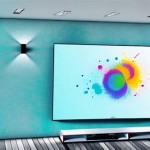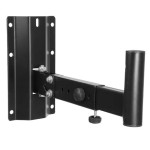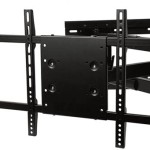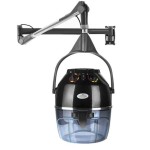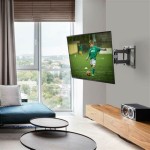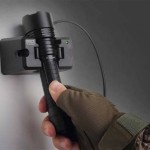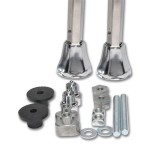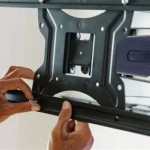Mounting a 55-Inch Samsung TV: A Comprehensive Guide
Selecting and installing a wall mount for a 55-inch Samsung television requires careful consideration of several factors. This article provides a detailed examination of the process, encompassing necessary preparations, hardware options, installation procedures, and post-installation adjustments. Understanding these aspects ensures a secure and aesthetically pleasing installation, optimizing viewing experience and minimizing potential damage to the television and surrounding wall structure.
The popularity of wall-mounted televisions is driven by several advantages, including space optimization, enhanced aesthetics, and improved viewing angles. By freeing up floor space, a wall-mounted TV creates a cleaner, more modern look. Furthermore, strategically positioning the television at eye level eliminates neck strain and enhances viewing comfort. However, successful wall mounting hinges on selecting the appropriate mount and implementing proper installation techniques. Neglecting these crucial steps can lead to instability, damage, or even failure of the mounting system.
Determining Wall Mount Compatibility and Type
Prior to purchasing a wall mount, verifying compatibility with the specific Samsung television model is essential. This primarily involves examining the Video Electronics Standards Association (VESA) mounting pattern on the back of the television. The VESA pattern refers to the standardized screw hole layout used by television manufacturers. This pattern is expressed in millimeters, such as 200x200 or 400x400, indicating the horizontal and vertical distances between the mounting holes.
The television's specifications, typically found in the user manual or on the manufacturer's website, will explicitly state the VESA compatibility. Failure to match the VESA pattern of the television with the mount's specifications can result in an incompatible installation, rendering the mount unusable. Some mounts offer universal compatibility, accommodating a range of VESA patterns through adjustable brackets or extensions. While these "universal" mounts offer flexibility, it is crucial to ensure they are still rated for the weight and dimensions of the 55-inch Samsung television.
Beyond VESA compatibility, understanding the different types of wall mounts is crucial for selecting the appropriate option. The primary types include fixed, tilting, and full-motion mounts. Each type offers unique advantages and disadvantages depending on the desired viewing experience and installation environment.
Fixed mounts offer the simplest and most cost-effective solution. They hold the television flush against the wall, providing minimal movement or adjustability. This type is suitable for situations where the viewing angle is consistently aligned with the television's position and where minimizing the distance between the television and the wall is a primary concern. Fixed mounts are generally easier to install than other types due to their straightforward design.
Tilting mounts allow for vertical adjustment of the television's angle. This is particularly useful for installations where the television is mounted higher than eye level, as the downward tilt compensates for the viewing angle and reduces glare. Tilting mounts offer a compromise between fixed and full-motion mounts, providing some adjustability without the complexity or expense of a full-motion system.
Full-motion mounts, also known as articulating mounts, offer the greatest flexibility. They allow the television to be swiveled left or right, tilted up or down, and extended away from the wall. This type is ideal for situations where the viewing angle needs to be adjusted frequently, such as in open-plan living spaces or multi-purpose rooms. Full-motion mounts are typically the most expensive and challenging to install due to their complex mechanisms and increased weight capacity requirements.
Preparation and Wall Structure Assessment
Before commencing the installation process, thorough preparation is essential. This involves gathering the necessary tools, identifying wall studs, and verifying the wall's structural integrity. A well-prepared workspace minimizes delays and ensures a safe and effective installation.
Essential tools include a stud finder, level, drill, screwdriver (both Phillips head and flathead), measuring tape, pencil, and potentially a hammer. A stud finder is crucial for locating the wall studs, which are the vertical framing members that provide structural support. Some stud finders utilize electronic sensors, while others rely on magnetic detection. Choosing a reliable stud finder is critical for accurately locating the studs.
A level is necessary to ensure the television is mounted straight and level. Digital levels offer greater precision, but a traditional bubble level is typically sufficient. A drill is required to create pilot holes for the mounting screws, and a screwdriver is used to secure the mount to the wall and the television to the mount. Measuring tape is used to mark the desired location of the mount and to verify the VESA pattern. A pencil is used to mark the stud locations and the placement of the mounting bracket.
Identifying wall studs is a critical step in the installation process. Mounting the television directly to the drywall without securing it to the studs can result in the television falling off the wall. Studs are typically spaced 16 or 24 inches apart. Using a stud finder, locate the edges of the studs and mark their positions with a pencil. Multiple readings should be taken to confirm the stud locations. If a stud finder is unavailable, alternative methods include tapping on the wall and listening for a solid sound or examining the location of electrical outlets and switches, as these are often attached to studs. Note that relying on these methods alone may not be as reliable as using a stud finder.
Once the stud locations are identified, assess the wall's structural integrity. The wall must be capable of supporting the weight of the television and the mount. Inspect the drywall for any signs of damage, such as cracks or water stains, which may indicate underlying structural issues. If the wall is constructed of a material other than drywall, such as concrete or brick, specialized mounting hardware and techniques may be required. Consult with a qualified professional if there are any concerns about the wall's ability to support the television.
For concrete or brick walls, specialized anchors are required to ensure a secure installation. These anchors must be rated for the weight of the television and the mount. The installation process for concrete or brick walls typically involves drilling holes into the wall and inserting the anchors. This process can be more challenging than mounting to drywall and may require specialized tools, such as a hammer drill.
Executing the Installation Process
With the preparatory steps completed, the actual installation process can commence. This involves attaching the mounting brackets to the television, attaching the wall plate to the wall studs, and connecting the television to the wall plate. Following the manufacturer's instructions carefully is crucial for a successful installation.
Begin by attaching the mounting brackets to the back of the television using the screws provided with the wall mount. Ensure the brackets are aligned correctly with the VESA mounting pattern. Tighten the screws securely, but avoid over-tightening, as this can damage the television's housing. Refer to the television's user manual for specific torque recommendations, if available.
Next, attach the wall plate to the wall studs. Position the wall plate at the desired location, ensuring it is level. Use a pencil to mark the locations of the mounting holes on the studs. Drill pilot holes into the studs at the marked locations. Align the wall plate with the pilot holes and secure it to the studs using the lag bolts provided with the wall mount. Tighten the lag bolts securely, ensuring the wall plate is firmly attached to the wall. Double-check the level of the wall plate before fully tightening the bolts.
Finally, carefully lift the television and connect it to the wall plate. Most wall mounts utilize a hook-and-latch system, where the mounting brackets on the television engage with the wall plate. Ensure the television is securely connected to the wall plate before releasing it. Some mounts may require additional screws or locking mechanisms to secure the television in place. Consult the manufacturer's instructions for specific details.
After the television is connected to the wall plate, double-check the level and stability of the installation. Gently wiggle the television to ensure it is securely mounted. If there is any movement or instability, re-tighten the lag bolts and mounting screws. If the problem persists, re-evaluate the wall's structural integrity or consult with a qualified professional.
Cable management is an important aspect of wall-mounted television installations. Hide cables behind the television using cable ties, cable sleeves, or in-wall cable management systems. This creates a cleaner, more organized look and prevents cables from becoming tangled or damaged. Consider using a cable box or media console to house the television's accessories and further conceal the cables.
Post-installation adjustments may be necessary to optimize the viewing experience. Adjust the tilt or swivel of the television to achieve the desired viewing angle. Check the picture settings on the television to ensure they are optimized for the viewing environment. Consider using a professional calibration service to achieve the best possible picture quality.

Dwf2655x 26 To 55 Flat Panel Fixed Wall Mount Television Home Theater Accessories Samsung Us

Samsung Qled 4k 2024 Q90r On No Gap Mount 55q90r Wall Install Youtube

No Gap Wall Mount For 65 55 Q Series Tvs Television Home Theater Accessories Wmn M11eb Za Samsung Us

Display Solutions Wall Samsung Wmn 55vd Mount 55 Inch Visitelecom Information Communication Technology

2024 Samsung 55 S95d 4k Oled S Tv Unboxing And Wall Mounting Matte Finish

Fits Ue55nu7670 Samsung 55 Ultra Slim Tv Bracket Wall Mount For Tvs Uk

Samsung Ua55tu8000 Tv Wall Mount

Display Solutions Wall Samsung Wmn 55vd Mount 55 Inch Visitelecom Information Communication Technology

Samsung Auto Rotating Wall Mount In Black Vg Arab43wmtxa

Universal Tilt Tv Wall Mount Bracket For Samsung 55 Singapore U

